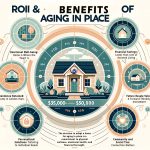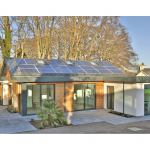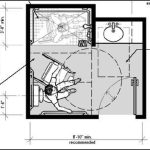Multigenerational Living
Are you ready for a change in the way your family lives together? Multigenerational living, a growing trend where multiple generations reside under one roof, is reshaping the way we think about our homes. This living arrangement not only fosters a supportive and caring environment but also offers financial advantages and shared caregiving responsibilities.
However, when it comes to accommodating the unique needs of family members with chronic conditions or those planning to age in place, accessible home design becomes an essential consideration. This is where the expertise of aging in place consultants and home remodeling services comes into play, helping to create a safe, comfortable, and functional home that caters to everyone’s needs.
Join us as we explore the ins and outs of multigenerational living, the importance of accessible home design, and the role of professional services in transforming your home into a haven for every generation.
Understanding Multigenerational Living
Multigenerational living is an arrangement where at least two adult generations coexist under the same roof, such as adult children living with their parents, aging parents moving in with their children, or households with a family member facing chronic health challenges. This living situation offers a plethora of advantages, including financial savings, emotional support, and shared caregiving responsibilities.
Several factors contribute to the rising popularity of multigenerational households. Economic pressures, an aging population, and cultural preferences are driving more families to embrace this lifestyle. By combining resources and offering mutual support, family members can better navigate life’s challenges.
In multigenerational homes, it’s crucial to address the healthcare needs of each age group to maintain a harmonious living environment. This often involves adapting the home’s design and features to accommodate everyone’s requirements, ensuring that every member of the family can thrive.
As you consider embracing multigenerational living, it’s essential to understand the dynamics of this lifestyle and the ways in which you can create a nurturing and supportive environment for all family members.

The Importance of Accessible Home Design
Accessible home design is of paramount importance when creating an environment where family members with chronic conditions or those planning to age in place can feel safe and comfortable. By focusing on accessibility, you can ensure that everyone in the household can participate in daily activities with ease and security.
Universal design principles are a key component of accessible home design. These principles aim to make spaces functional and appealing for people of all abilities, ensuring that no one feels excluded or disadvantaged. By incorporating universal design elements, you can create a living space that is both practical and aesthetically pleasing.
In addition to design principles, technology and assistive devices play a crucial role in enhancing wellness and independence for those living with chronic conditions. From smart home systems to adaptive equipment, there are numerous options available to make daily tasks more manageable and improve the overall quality of life for individuals facing challenges.
Embracing accessible home design is not only beneficial for those with chronic conditions or aging family members but also fosters a more inclusive and supportive environment for the entire household. By considering the needs of every family member and incorporating accessibility features, you can create a home that is truly welcoming and accommodating for all.
The home modification checklist provides a comprehensive guide to evaluate your home’s accessibility and safety needs. It’s important to recognize that every individual’s needs are unique.
Designing a Multigenerational Home
Creating a multigenerational home requires thoughtful planning and design. By adapting the floor plan to accommodate the needs of extended family members, you can ensure a comfortable and functional living environment for everyone. This may involve creating separate living spaces, adding additional bedrooms, or even designing an in-law suite.
In addition to floor plan adjustments, integrating specific design elements for aging parents and adult children is essential. This may include wider doorways to accommodate wheelchairs or walkers, ramps for easy access, and easy-to-use fixtures to make daily tasks more manageable. By addressing the unique needs of each family member, you can create a living space that promotes independence and well-being.
Interior design and home decor considerations are equally important when designing a multigenerational home. To create a harmonious and inviting space, consider the preferences and needs of each generation. Incorporate colors, patterns, and furniture that cater to various ages and tastes, while also ensuring that the design is functional and accessible for all.
Ultimately, designing a multigenerational home involves a delicate balance of practicality, aesthetics, and inclusivity. By keeping the needs and preferences of all family members in mind, you can create a home that fosters strong connections and supports the well-being of every generation.
Remodeling for Accessibility and Safety

Remodeling for accessibility and safety is essential for individuals with chronic conditions and those planning to age in place. By making key home modifications tailored to specific conditions, such as multiple sclerosis (MS), Parkinson’s, amyotrophic lateral sclerosis (ALS), and cerebral palsy, you can significantly improve their quality of life.
For instance, individuals with MS or Parkinson’s might benefit from installing grab bars in the bathroom and by the bed, widening doorways to accommodate wheelchairs or walkers, and adding ramps or stairlifts to help navigate different levels of the home. Those with ALS or cerebral palsy may require additional modifications like ceiling-mounted patient lifts and accessible workspaces.
Adapting living spaces for aging in place often involves making practical changes in the bathroom, kitchen, bedroom, and living room. These may include walk-in showers or tubs, adjustable countertops, and strategically placed lighting. By making these adjustments, you can create a living environment that is safe, comfortable, and supportive for older family members.
Improving mobility and accessibility throughout the home is another essential aspect of remodeling for multigenerational living. Consider creating clear pathways, removing tripping hazards, and installing non-slip flooring to prevent accidents. Smart home technology can also play a role in enhancing accessibility and safety by enabling voice-activated controls for lights, thermostats, and other household systems.
In summary, remodeling for accessibility and safety is a crucial step in creating a welcoming and functional multigenerational home. By addressing the unique needs of family members with chronic conditions and those aging in place, you can ensure that everyone can live comfortably and independently.
The Emotional Impact of Accessible Home Design
The emotional impact of accessible home design is profound, particularly for family members with chronic conditions. Thoughtful design and home modifications can greatly enhance their quality of life by enabling them to engage in daily activities with ease and safety. This not only reduces stress and frustration but also promotes a sense of accomplishment and self-worth.
Accessible design also plays a critical role in fostering independence and dignity for individuals with chronic conditions or those aging in place. By providing an environment that accommodates their needs, they can maintain a sense of control over their daily lives, which is crucial for mental and emotional well-being.
Moreover, shared living spaces that cater to the preferences and needs of all family members can significantly strengthen family bonds and connections. When everyone feels comfortable and supported in their living environment, they are more likely to engage in meaningful conversations, participate in shared activities, and form lasting memories together. This creates a strong foundation for nurturing multigenerational relationships and fosters a sense of belonging for all family members.
In conclusion, accessible home design has a powerful emotional impact on individuals with chronic conditions and their families. By creating a safe, comfortable, and functional living environment, you can improve the quality of life for your loved ones, encourage their independence, and strengthen family connections.
Planning for Home Modifications
When considering home modifications to create a multigenerational living space, it’s essential to approach the process thoughtfully and strategically. Start by consulting with aging in place and accessible home design experts. These professionals have the knowledge and experience to help you identify the most effective and practical changes for your specific needs. They can guide you through the process, ensuring your home meets the requirements of all family members.
Next, evaluate the costs and benefits of remodeling. While there may be upfront expenses involved, the long-term advantages of creating a safe, comfortable, and functional home for all generations should not be overlooked. Consider factors such as improved quality of life, increased safety, and the potential for long-term financial savings through shared living expenses.
Finally, explore financial assistance options to help offset the costs of remodeling. There are various grants, loans, and tax incentives available to help make home modifications more affordable. Investigate local, state, and federal programs, as well as non-profit organizations that may provide financial support for accessible home design projects.
In summary, planning for home modifications involves consulting with experts, assessing the costs and benefits of remodeling, and exploring financial assistance options. By approaching the process with care and foresight, you can create a multigenerational home that meets the needs of all family members, promoting a comfortable and supportive living environment.
Start the Process of Home Modifications
If you’re considering creating a multigenerational home that caters to the healthcare needs of your family members, there’s no better time to start the process of home modifications. By reaching out to our team of aging in place consulting and accessible home design professionals, you’ll gain access to invaluable expertise and guidance to help you create a safe, comfortable, and functional home for every generation.
Working with our professionals comes with several benefits. We can assist in identifying essential modifications, tailoring designs to suit your family’s unique requirements, and providing ongoing support throughout the project. Our primary goal is to help you create a nurturing environment that fosters independence, dignity, and strong family connections for all your loved ones.
Don’t wait to invest in the well-being of your family. Start making your home a welcoming space that accommodates everyone’s needs, regardless of age or ability. Contact us today to discuss your specific requirements and learn how we can help transform your home into a haven for multigenerational living.









